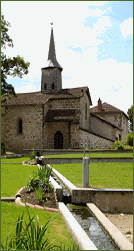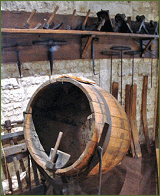|
In order for the brandy to be called a cognac, it must be
distilled twice in copper pot stills and then aged for at least 2 years in traditional
French oak barrels that are air-tightly sealed.
A related drink produced in another region is armagnac from Armagnac and calvados (spirit)
from the Basse-Normandie or Lower Normandy region.
Along with armagnac in Armagnac, France and sherry in Jerez, Spain, Cognac is one of only
three officially demarcated brandy regions in Europe.
The region of Cognac which is technically a commune in the French departement of Charente
is divided up into six growth areas, known as crus or cru, and cover the departments
of the Charente-Maritime, a large part of the Charente and a few areas in Deux-Sèvres and
the Dordogne.
The six crus are, in order of decreasing appreciation of the cognacs coming from them:
Grande Champagne, Petite Champagne, Borderies, Fins Bois, Bons Bois, and Bois Ordinaires.
A cognac made from just the first two of these crus (with at least 50% from Grande
Champagne) is called "fine champagne cognac". And the
"champagne" comes from archaic words meaning chalky soil, which is a
characteristic of both areas.
Yet even if a brandy is produced within the defined region and fails to meet any of the
strict criteria set down by the governing body of cognac production, it may not be called
cognac, nor sold as such. This why, although you see many types of brandy on sale,
the brandy produced elsewhere in France or in the world for that matter, cannot legally be
called "cognac".
Some basic criteria for cognac:
It must be produced within the set region, from wine using specific grape
varieties.
It must be obtained through double distillation, in typical copper Charentais
stills.
It must be aged in French oak barrels for a minimum of two years, which give it
part of its colour and part of its taste.
The age of the cognac is calculated as that of the youngest eau-de-vie used in the
blend. The blend is usually of different ages and in the case of the larger and more
commercial producers is also produced from different local areas. This blending of
the different eaux-de-vie is important to obtain a complexity of flavours absent from an
eau-de-vie from a single distillery or vineyard.
Known as a Maitre de Chai, each cognac house has a master taster who is responsible for
creating this delicate blend of spirits, so that the cognac produced by a company today
will taste almost exactly the same as a cognac produced by that same company 50 years ago,
or in 50 years' time.
There are hundreds of vineyards in the Cognac region who sell their own cognac. These are
likewise blended from the eaux-de-vie of different years, but they are single-vineyard
cognacs, which vary slightly from year to year and according to the taste of the producer,
hence lacking some of the predictability of the better-known commercial products, but
provide variety of experience. The small producers will sell their product to
individual buyers, wine dealers, bars and restaurants, with the remainder being acquired
by larger cognac houses for blending.
So if you want to experience Cognac, then many of the cognac producers in the town of
Cognac and the surrounding area allow visitors to taste their product and some of the
larger companies have guided tours to show visitors how the cognac is made.
|
|



